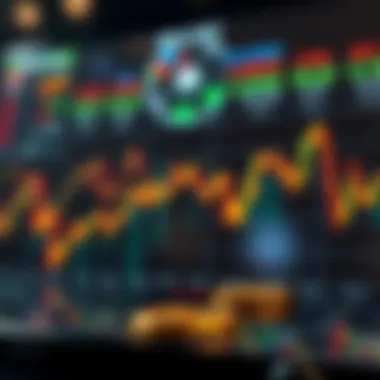Decoding Crypto Stock Graphs for Informed Investing


Intro
The cryptocurrency market has become a dynamic landscape, full of intriguing opportunities and substantial risks. As the adage goes, "Don’t put all your eggs in one basket," and this could not be more applicable in the volatile world of crypto trading. Understanding crypto stock graphs is essential for investors and enthusiasts alike. These graphs serve as a compass, guiding market navigation in an increasingly complex environment.
This exploration will not only discuss the fundamental aspects of interpreting various types of stock graphs but also analyze how they can greatly influence investment decisions. By grasping the nuances behind market movements, one can develop a stronger, more nuanced perspective on their investments. The significance of reliable data sources and market sentiment will also be examined, providing varied insights into the complexities of cryptocurrency trading.
Ultimately, whether you are an experienced investor or a newcomer, this narrative aims to enrich your understanding and help you analyze cryptocurrencies with confidence and clarity.
Market Insights
Understanding market trends is crucial for anyone delving into cryptocurrency trading. This section breaks down current trends and key indicators that shape market analysis, providing a robust framework for assessing cryptocurrencies.
Current Trends in Cryptocurrency Markets
Cryptocurrency is not a stagnant industry; it evolves continuously. The past couple of years have illustrated ups and downs, with major fluctuations observed in Bitcoin, Ethereum, and other altcoins. From decentralized finance (DeFi) to non-fungible tokens (NFTs), there are various trends driving market behaviors.
Keeping an eye on regulatory developments, technological advancements, and societal acceptance can give insights into potential future trends. It is noteworthy that market sentiments often lead price fluctuations. For instance, positive news around Bitcoin's acceptance by major corporate entities can lead to bullish trends.
- New blockchain partnerships and integrations
- Heightened interest in Ethereum 2.0 upgrades
- Social media's impact on sentiment and trading behavior
Key Indicators for Market Analysis
When analyzing cryptocurrency markets, there are several key indicators to consider:
- Volume: This is a telling sign of trader interest. High volume signifies that a price change will likely hold.
- Market Cap: Understanding a cryptocurrency's market cap can help gauge its dominance and stability.
- Price Patterns: Patterns such as head and shoulders, flags, and triangles present insight into future movements.
- Sentiment Analysis: Utilizing platforms like Reddit or Twitter for sentiment analysis can reveal the general feelings surrounding specific assets.
Investors should always stay informed. For comprehensive information on market trends, databases like CoinMarketCap and CoinGecko can be invaluable tools.
Blockchain Innovations
Emerging blockchain technologies and their applications are crucial to understanding the potential behind cryptocurrencies. This innovative tech not only powers digital currencies but also revolutionizes many industries.
Emerging Blockchain Technologies
Innovations in blockchain are a popular topic nowadays, continually shaping the digital currency landscape. Technologies like Layer 2 scaling solutions, interoperable blockchains, and privacy-focused protocols enhance transaction scalability and security.
An example of this is the rise of Ethereum sidechains, which allow for quicker transactions while relieving the main chain's load. Innovations like these are making blockchain not just a buzzword but a solid foundation for the future of finance and other sectors, including supply chain management and healthcare.
Real-world Applications of Blockchain
The implications of blockchain extend far beyond just cryptocurrencies:
- Supply Chain Management: Ensures transparency and traceability of products.
- Healthcare: Secures patient data without compromising privacy.
- Energy Trading: Facilitates peer-to-peer energy trading.
With more businesses adopting blockchain, understanding these applications can equip investors with a broader outlook on future market opportunities and challenges.
"Blockchain is more than just technology; it is changing the way we interact with the world."
Reading and interpreting crypto stock graphs can bring to light these evolving trends and innovations, shaping your investment strategies for the better.
Prologue to Crypto Stock Graphs
In the fast-paced world of cryptocurrency, graphs serve as essential navigational aids. Investors and enthusiasts often find themselves swimming in a sea of market data, and grasping that data visually can make the difference between success and frustration. Understanding crypto stock graphs isn't just helpful – it's crucial for anyone wanting to make informed decisions in this unpredictable landscape.
Defining Crypto Stock Graphs
Crypto stock graphs are visual representations of price movements and trading volumes of cryptocurrencies over certain time periods. These graphs help traders and investors to quickly assess the price trends and fluctuations for various digital assets. The left-hand side typically indicates the chronological timeline, while the vertical axis shows the price points. Essentially, they turn complex numerical data into something that’s more digestible.
The core types of graphs — line graphs, candlestick charts, and bar charts — each have unique features that cater to different analytical needs. For instance, while a simple line graph might show a basic trend, a candlestick chart gives much more detail, allowing for deeper interpretations regarding potential price continuations or reversals. With every investment decision riding on proper analysis, understanding these tools becomes mandatory.
The Significance of Graphs in Financial Markets
Graphs are not merely artistic representations devoid of substance; they encapsulate crucial market sentiments and investor psychology. By studying these graphs, one can glean insights into market trends, pattern formations, and psychological barriers like support and resistance levels. Prices tend not to rise or fall in a vacuum; they echo participants' emotions in the market — fear, excitement, and greed.
“Graphs encapsulate the psychological canvas of the market, reflecting investor emotions along with hard data.”
Moreover, analyzing these graphs grants another layer of understanding. For instance, sudden spikes in trading volume may suggest increased social media chatter or market events that could potentially influence price strongly. Conversely, dips could signify emerging problems, like regulatory news or market failures. Thus, adeptly interpreting these graphs allows investors to navigate potential pitfalls while capturing opportunities.
In sum, the role of crypto stock graphs in financial markets is indispensable. They empower investors with the knowledge needed to decipher the ever-changing landscape of cryptocurrency investments, ensuring that decision-making is rooted in empirical evidence rather than conjecture.
Types of Crypto Stock Graphs
Understanding the types of crypto stock graphs is essential for anyone diving into the cryptocurrency space. These visual aids, each designed with a different focus in mind, provide valuable insights that can help investors and enthusiasts make informed decisions. Each graph type offers unique properties that reveal different aspects of market dynamics, thus catering to diverse analytical needs. Let's break down the main varieties of graphs you’re likely to encounter.
Line Graphs
Line graphs present a simple yet effective way to visualize price trends over a period of time. They consist of a continuous line that connects closing prices at various time intervals. This clarity allows investors to spot general trends easily and track an asset's performance over a specific timeframe.
For instance, if you're observing Bitcoin’s price over several weeks, a line graph can help you see whether it's bullish or bearish at a glance. This type of graph shines when you want a clear picture of a security’s performance without the noise of intraday fluctuations.


- Pros: Easy to read, ideal for highlighting overall price movement, less cluttered than other graphs.
- Cons: Lacks details about trading volume or daily price movements, which can be important to day traders.
In the volatile world of cryptocurrency, having a quick way to assess the general direction of a market can inform your buy and sell strategies without drowning you in excessive detail.
Candlestick Charts
Candlestick charts offer a wealth of information that can be pivotal in understanding market psychology. Each candlestick represents a specific time period (like a day, an hour, or a minute) and shows the open, high, low, and close prices within that timeframe.
The body of the candlestick shows whether the closing price was higher or lower than the opening price. The wicks extend to indicate the highest and lowest prices reached. When you examine a series of these candlesticks, you get to see not just the overall trend but also the battle between buyers and sellers, which can lead to moments of volatility.
- Pros: Provides a detailed view of price action, great for identifying short-term trends and reversals, popular among technical analysts.
- Cons: Can be a bit overwhelming for beginners due to the amount of data shown,
Understanding candlestick patterns, like the hammer or engulfing patterns, can give insights into possible future movements. This nuanced view of the market helps traders apply strategies based on market sentiment.
Bar Charts
Bar charts, like candlesticks, display open, high, low, and close values but do it in a slightly different manner. They represent market data in vertical bars where each bar indicates the price range during a specific period. The left mark of the bar shows the opening price, while the right mark shows the closing price.
These charts blend simplicity with detail.
- Pros: Easy to read while providing comprehensive data at a glance, effective for spotting market trends and reversals.
- Cons: Might lack the visual appeal of candlestick charts, which some traders prefer for better representation of the market.
Investors looking for a balance between simplicity and information may find bar charts to be a dependable choice. They can reveal key price levels just as effectively as their more popular cousins.
Understanding Graph Components
Understanding the components of crypto stock graphs is fundamental for investors and enthusiasts alike. By grasping these elements, individuals can better their decision-making processes when trading or investing in cryptocurrencies. Each component contributes to a more comprehensive interpretation of the market and helps identify trends that may not be immediately obvious.
Axes and Scaling
When one first approaches crypto stock graphs, the axes present a basic framework that carries significant implications. On a typical graph, the vertical axis usually represents price, while the horizontal axis depicts time. Understanding how to read these axes is crucial.
- The vertical axis indicates the price of the cryptocurrency in question, allowing investors to see how high or low the price has gone over a defined time frame.
- The horizontal axis provides timelines, which can range from minutes to years depending on what traders wish to analyze.
Scaling, on the other hand, tells you how detailed the view will be. A finely scaled graph can help identify subtle price movements, while a broader scale might be more beneficial for spotting long-term trends. For instance, an investor keen on daily price fluctuations should lean towards lower timeframes; conversely, someone considering long-term investments might prefer a wider scale. The choice of scaling thus significantly influences one’s strategy and assessment of market potential.
Timeframes in Crypto Graphs
Timeframes play a key role in the analysis of cryptocurrency markets. Different timeframes can tell very different stories. The practice of using varied timeframes can illuminate both short- and long-term trends.
- Short Timeframes: Some traders focus on 1-minute or hourly charts to capitalize on immediate price movements. These provide a granulated perspective, ideal for day trading strategies.
- Medium Timeframes: Many investors use daily or weekly charts. These are often more reliable indicators of broader trends without the noise of minute-by-minute price changes.
- Long Timeframes: Using monthly charts or longer, investors can spot overarching trends that signal when to enter or exit a market position.
The importance of selecting the right timeframe lies in aligning it with one’s trading or investment goal. For example, if you’re aiming to ride a trend over months, a daily chart might be necessary, but if you’re looking to react quickly to movements, smaller timeframes will be more appropriate.
Volume Indicators
Volume indicators present another layer of competency in interpreting crypto stock graphs. In this dynamic market, understanding trading volume is essential to validate price movements.
- High volume often suggests stronger conviction in price movements. For instance, a price rise on substantial volume might indicate a true uptrend, while a price rise accompanied by low volume may signal a lack of support.
- Conversely, declining volume during a price drop could imply that the sell-off is losing momentum, indicating that a potential reversal could occur.
Investors can use volume with other indicators like the Moving Average or Relative Strength Index to attain more comprehensive insights. Volume not only informs about the strength of price movements but can also prelude potential market shifts. If one ignores volume indicators, they miss out on critical insights that are pivotal for informed decision-making.
Remember, understanding the components of crypto stock graphs not only enhances predictive accuracy but also encourages a disciplined approach to trading.
Interpreting Crypto Stock Graphs
Interpreting crypto stock graphs can make or break your experience in the fast-paced world of cryptocurrency. Understanding these graphs allows investors to make informed decisions based on price trends, market sentiment, and various indicators. In a market characterized by volatility, the ability to interpret these patterns means you can stay a step ahead of fluctuations, increasing your chances of success.
One of the critical benefits of mastering chart interpretation is that it helps demystify the market behavior of cryptocurrencies. By visualizing price movements and trends over time, investors can identify potential entry and exit points for trades or investments. Instead of relying on gut feelings or hearsay, one can get a clear view based on solid data and analyses. This is particularly relevant in cryptocurrency trading, where data-backed insights can often lead to higher profits.
Reading Price Trends
To effectively read price trends on crypto stock graphs, it is essential to pay close attention to the price direction over specific periods. A consistent upward trend may indicate growing investor confidence and can be a sign to buy. Conversely, a downtrend might suggest selling opportunities or caution.
Conversely, sideways movements suggest indecision in the market. During these times, both bulls (buyers) and bears (sellers) may be contesting control. Recognizing these trends involves analyzing peaks and troughs alongside volume patterns, drawing essential connections between graph movements and potential market shifts.
Understanding Support and Resistance Levels
Support and resistance levels are two pivotal concepts that every crypto trader needs to grasp. Support levels signify a point where buying interest outweighs selling pressure, which can halt price declines. In contrast, resistance levels indicate price ceilings where selling pressure becomes strong enough to prevent further buying. Understanding these dynamics is crucial for predicting price movements.
When crypto price approaches support, traders often consider it a buying opportunity, while hitting resistance may point to a necessary decision to hold or sell.
Recognizing Patterns and Signals
Recognizing patterns and signals on crypto charts is integral for making strategic trading decisions. Some common patterns traders look for include those outlined below:
Head and Shoulders
The Head and Shoulders pattern is considered a classic reversal signal. It's characterized by three peaks: a higher peak (head) surrounded by two lower peaks (shoulders). This signals a potential price top and suggests that the market might be reversing from an uptrend to a downtrend. One key characteristic that makes this pattern popular among traders is its reliability—many consider it a leading indicator of trend shifts. Traders often use this to set stop-loss orders or adjust their positions accordingly. However, it’s crucial to confirm this pattern with additional indicators to manage risks.
Double Tops and Bottoms


The Double Tops pattern is another significant reversal indicator, consisting of two peaks at roughly the same price level, signaling resistance. In contrast, a Double Bottom pattern suggests a potential reversal point following a downtrend with two troughs at similar levels. This feature reflects indecision and can provide powerful signals for traders looking to capitalize on market reversals. Both patterns have the advantage of being visually recognizable, aiding in swift decision-making. However, it’s essential not to rely solely on these patterns to avoid costly mistakes.
Triangles and Consolidations
Triangles and consolidations represent periods of price squeezing, typically indicating a potential breakout or breakdown. These formations can take various shapes, such as ascending, descending, or symmetrical triangles, and reflect market hypothesis as traders weigh their positions. They are particularly advantageous for planning short-term trading strategies, as traders can set up trades in anticipation of volatility.
Ultimately, understanding these patterns and signals can enhance an investor's capacity to engage effectively in the crypto marketplace. Proper interpretation leads to calculated entries and exits, maximizing profit potential while minimizing risk.
The Role of Technical Analysis in Crypto Trading
In the fast-paced world of cryptocurrency, where sentiment can change with the blink of an eye, technical analysis serves as a beacon for traders and investors alike. This analytical approach allows individuals to interpret price movements through charts, identifying potential patterns that can signal future price behavior. Technical analysis relies on historical price and volume data, providing a structured method for evaluating market trends.
Chart Indicators and Their Functions
A cornerstone of technical analysis are chart indicators, which help distill vast amounts of price information into visually comprehensible formats. These indicators can provide insights into market momentum, the strength of price trends, and potential reversal points. Knowing how to use these indicators is essential for anyone venturing into crypto trading.
Moving Averages
Moving Averages (MAs) are a key tool in the arsenal of any trader looking to smooth out price data over a specified period. The primary function of a moving average is to mitigate volatility within the market. By averaging out price points, this indicator helps to highlight the direction of the trend.
One characteristic that makes MAs popular is their simplicity; they are easy to understand and implement in trading strategies.
- Simple Moving Average (SMA): Calculates the average price over a set number of periods. This helps illustrate the overall trend without the noise of short-term fluctuations.
- Exponential Moving Average (EMA): Places greater weight on recent prices, which makes it more responsive to new information compared to the SMA. This is particularly useful for traders seeking quick reactions to price changes.
However, relying solely on MAs can lead to misinterpretations during sideways market conditions where trends are less distinguishable. The merit of MAs lies in its utility in recognizing trends, yet it is important to combine them with other analysis methods to avoid pitfalls.
Relative Strength Index (RSI)
The Relative Strength Index (RSI) evaluates the momentum of price movements by comparing the magnitude of recent gains with recent losses. The RSI ranges from 0 to 100 and, traditionally, a reading above 70 indicates overbought conditions while a reading below 30 signals oversold conditions.
What sets RSI apart is its ability to provide insight into whether an asset might be overbought or oversold. This feature makes it a powerful indicator for spotting potential reversals in trends.
- Usefulness: Traders utilize the RSI to time their entries and exits more effectively, seeking to capitalize on price corrections resulting from overextending movements.
- Caution: However, as with any tool, it’s vital to watch for false signals. Markets can stay overbought or oversold for extended periods, which might lead to premature actions.
Bollinger Bands
Bollinger Bands consist of a middle band (the SMA) surrounded by two outer bands. These bands expand and contract based on market volatility, offering traders a visual representation of current market conditions.
- Key Feature: The widening of the bands indicates increased volatility, whereas narrowing suggests a period of low volatility, which often precedes a significant price movement.
- Benefits: The ability of Bollinger Bands to show price volatility enables traders to set realistic expectations. When prices break through the upper or lower bands, it can indicate potential buy or sell signals.
Nonetheless, relying solely on Bollinger Bands without considering other indicators might mislead traders. It’s advisable to incorporate additional analysis to confirm signals and foster informed trading decisions.
Combining Graphs with Fundamental Analysis
It’s essential to understand that while technical analysis provides valuable insights, it’s incomplete without the application of fundamental analysis. Market conditions, overarching economic indicators, and news developments profoundly affect the cryptocurrency market. Combining both methodologies enhances one's ability to predict market movements more accurately, ultimately leading to more informed trading decisions.
Common Misconceptions About Crypto Stock Graphs
In the realm of cryptocurrency, graphs are seen not just as visual aids, but as crucial navigational tools for investors and speculators alike. However, there are several misconceptions surrounding their use that can lead to poor investment decisions. It’s important to clear the air on these myths to enhance our understanding of how to effectively utilize crypto stock graphs in trading and investing.
Overreliance on Graphs
One of the most prominent misconceptions is the overreliance on graphs for making investment decisions. While these visual representations provide invaluable insights, placing excessive faith in them can be dangerous. Many traders believe that understanding patterns in graphs will lead to guaranteed profits. This belief often leads to a disconnection from the underlying factors that influence market movements.
- Graph Limitations: Graphs primarily reflect past price movements and trends, not the future. They fall short in capturing external factors like regulatory changes, technological advancements, or macroeconomic developments that could significantly affect the market.
- Emotional Decision Making: Traders might act impulsively based on what they see in the graphs rather than considering broader market context. The fear of missing out (FOMO) or panic selling often overshadows rational analysis, resulting in erratic trading behavior.
Therefore, while graphs are essential, they should not serve as the sole basis for trading decisions. Investors should always complement graph analysis with diligent research into market conditions and news.
Ignoring Market Sentiment
Another common pitfall is the neglect of market sentiment. Graphs depict numerical data, but they often miss the emotional currents flowing beneath the surface. Understanding these sentiments is crucial for accurately interpreting what a graph conveys.
- Sentiment Analysis: The market is driven by the collective emotions of investors – fear, greed, optimism, or skepticism. While a chart showing a bullish trend might suggest a certain trajectory, if wider market sentiment turns sour due to unforeseen events, that trend might quickly reverse. Therefore, being aware of news, community discussions on platforms like Reddit or articles on Investopedia outlets can provide context that graphs alone cannot.
- Behavioral Economics Impact: Human psychology plays a vital role in trading. Events that cause panic or a sudden surge in excitement can take the market on wild rides. A well-rounded approach to crypto investing accounts for these elements, using graphs as one of several tools rather than a definitive guide.
"Graphs tell one side of the story; they need to be paired with the pulse of the market."
Sources for Reliable Graph Data
In the unpredictable world of cryptocurrencies, having access to reliable graph data can significantly impact investment decisions. Different platforms provide a variety of tools and resources for assessing market trends. The graphs illustrate price movements, trading volumes, and other pivotal statistics that traders and investors need. Consequently, selecting a trustworthy source is paramount. Here are some key elements to consider when looking into sources for reliable graph data:
- Data Accuracy: The foundational aspect of any reliable graph data source is accuracy. Misinformation can lead to poor investment choices. Therefore, ensure the platform aggregates data correctly and from reputable exchanges.
- Timeliness: In the fast-paced crypto market, real-time data isn’t just a luxury; it��’s a necessity. Sources that don’t provide up-to-date information might leave investors hanging.
- User Experience: Ease of navigation and clarity in displaying data can make or break the analysis process. Complicated interfaces can frustrate users, leading to errors in interpretation.
- Integration with Tools: A good source often allows for connectivity with analytical tools and software, making it easier to perform deeper analysis without switching platforms constantly.
- Community Trust: Platforms with a solid reputation within the crypto community usually have better data reliability. Engaging in discussions on platforms like Reddit or following industry experts on social media platforms can help identify trustworthy sources.
Investing in cryptocurrencies requires not just courage but a keen eye for reliable information. Using sound data sources lays the groundwork for savvy decision-making.
Reputable Exchanges and Platforms
When it comes to gathering data for crypto stock graphs, not all exchanges are created equal. Some stand out due to their focus on reliability and thorough reporting practices. Here are some notable exchanges where you can confidently source your chart data:
- Coinbase
- Binance
- Kraken


- Known for its user-friendly interface and reliability, this platform provides comprehensive charts that include price history, trading volumes, and market cap, catering well to novices and experts alike.
- As one of the largest cryptocurrency exchanges, Binance offers real-time data, including a wealth of information on various trading pairs. Its charts are customizable, allowing traders to view multiple indicators.
- With a focus on security and a wide range of tools for analysis, Kraken’s graph tools offer various features suitable for serious investors looking for in-depth data.
It’s critical to check user reviews and overall reputation before committing to any of these exchanges. They all have strengths and weaknesses, but many investors find these platforms dependable.
Leveraging Analytical Tools and Software
Understanding crypto stock graphs goes beyond merely reading them; employing analytical tools takes things to the next level. Here’s how leveraging such software can enhance your analysis:
- Integrated Analytics: Many advanced tools include built-in indicators and functions that help interpret data more effectively. Utilizing tools like TradingView enables you to apply numerous technical indicators directly onto the graphs.
- Backtesting Capabilities: Some software allows investors to test their strategies against historical data. This feature can be invaluable for determining how a strategy might perform in current market conditions.
- Customization Options: Graphs often come with preset layouts, but many platforms allow for customizing visual elements to prioritize information that matters most to the investor.
- Email Alerts: Certain platforms offer alert systems that notify users about price movements or significant changes in market conditions. This feature can help traders stay on top of fluctuating prices without constant monitoring.
By combining reliable graph data sources with analytical tools, investors can not only visualize trends but also gain actionable insights. This dual approach enables a comprehensive understanding of crypto stocks and can potentially lead to more profitable investment decisions.
Real-world Applications of Crypto Stock Graphs
Understanding crypto stock graphs goes beyond academic interest; it’s imperative for actionable insights in the bustling cryptocurrency market. These graphical representations serve as navigation tools for investors, aiding them in making informed decisions that can yield significant returns or mitigate losses. Each graph can reveal a plethora of information, from price movements to market cycles, all crucial for evaluating investment viability.
Investment Strategies
When diving into investment strategies, crypto stock graphs emerge as essential instruments. They enable traders to identify critical patterns, trends, and momentum, providing a foundation for sound investment decisions. Here's how they contribute to effective strategies:
- Identifying Entry and Exit Points: By observing trends over time, investors can spot favorable moments for buying or selling. Strategies like dollar-cost averaging can be better timed using graphs.
- Analyzing Historical Performance: Graphs facilitate a retrospective examination of how a cryptocurrency has performed in the past, allowing investors to draw conclusions and design predictive models for future movements.
- Tailoring to Risk Tolerance: Different graphs can appeal to various strategies—long-term investors might prefer line graphs for overall trends, while day traders could rely on candlestick charts for rapid fluctuations. Each method provides insights relevant to individual risk profiles.
Using these graphs effectively means that an investor can craft a robust strategy that’s not just guesswork but rooted in comprehensive data analysis.
Risk Management Techniques
Risk management is another pivotal area where crypto stock graphs play a critical role. The volatile nature of cryptocurrencies makes it essential to have a plan that considers potential downturns. Consider these techniques:
- Setting Stop-Loss Orders: By analyzing stock graphs, investors can determine price levels at which they should exit a position to minimize potential losses.
- Utilizing Volume Indicators: Understanding trading volume can help gauge the strength behind price movements. If a price increase accompanies high volume, it can signal strong interest, giving investors confidence in their holdings. Conversely, a price drop on low volume may not require immediate action.
- Diversification Tracking: Graphs allow investors to visualize the performance of various assets within their portfolio. This can inform decisions on when to rebalance investments or consider diversifying further.
"Graphs are not just images; they are the language of the market, speaking truths that numbers alone can't convey."
For further reading and resources on investment strategies and market analysis, visit:
Discover how the future of trading and investment can be shaped by understanding and applying crypto stock graphs.
Future Trends in Crypto Stock Graphs
As the realm of cryptocurrency continues to evolve at breakneck speed, so too do the tools we use to navigate it. Future trends in crypto stock graphs hold immense importance, particularly for investors and enthusiasts dedicated to making informed choices in this ever-changing landscape. Understanding these trends isn't just a plot twist in the tale—it's about anticipating shifts in the market that can greatly influence investment decisions.
Technological Advancements
The rise of technology has brought forth a wave of innovation impacting crypto stock graphs. First on the list are real-time data visualization tools. These tools enable investors to see price changes as they happen—no more waiting for end-of-day reports. An investor can spot an opportunity or a red flag in a split second and make necessary moves.
Another heavyweight in the game is mobile accessibility. With everything at your fingertips on sleek smartphones, the ability to access your trading graphs on the go is a game-changer. This type of accessibility has importantly broadened the demographics of crypto investors from seasoned professionals to curious newcomers.
"The tools we wield today are only limited by our imagination; stay informed, and you can stay ahead."
Moreover, the advent of blockchain technology itself has facilitated better data integrity and security in graphing methods. When investors trust the accuracy of data, they can base their decisions on solid ground, rather than clouds of uncertainty.
Integration of AI in Market Analysis
Looking ahead, the marriage of artificial intelligence (AI) and crypto stock graphs isn’t just a tantalizing prospect; it’s happening now. AI algorithms are becoming more sophisticated and can analyze vast amounts of data much quicker than any human ever could. They can identify trends and patterns that may escape even the keener eyes among us. For instance, some platforms now utilize machine learning techniques to process historical data, allowing them to make predictive trends about future price movements.
Investors can employ AI-driven insights to develop tailored trading strategies. With potential to increase efficiency, it can greatly impact decisions regarding buying or selling assets. The algorithms can also be programmed to continually improve over time, adapting to new data inputs and refining predictions.
Furthermore, these AI systems can scour sentiment analysis from social media and news sources, giving investors a more holistic view of the market. Knowing how public sentiment sways can be invaluable when evaluating chart patterns that would otherwise seem unclear. It allows for a broader context when analyzing why a particular asset might be moving in a certain direction.
For those prepared to harness these advancements, the future looks particularly promising.
The End: The Importance of Mastering Crypto Stock Graphs
In the rapidly changing landscape of cryptocurrency, the ability to understand and interpret crypto stock graphs has become crucial for anyone looking to engage seriously with this market. Mastering these graphs allows investors to make more informed decisions, tap into market trends, and ultimately manage their portfolios more effectively. The stakes are high, and the volatility of cryptocurrencies means that accurate and timely analysis can be the difference between profit and loss.
Essential Elements of Mastering Crypto Graphs
- Visualizing Market Dynamics: Graphs provide a visual representation of market fluctuations, summarizing vast amounts of data in a way that is more digestible. This visual aid becomes even more essential in a market characterized by rapid price swings.
- Identifying Patterns: The real magic in these charts lies in recognizing price patterns and chart formations. Patterns like head and shoulders or double bottoms can signal potential price movements, thus providing insights into when to enter or exit a trade.
- Linking Technical and Fundamental Analysis: Merging technical analysis, such as reading charts, with fundamental analysis builds a more holistic understanding of the market. It allows one to consider underlying factors like market news or changes in regulatory environments alongside price action.
- Risk Mitigation: A thorough understanding of graphs aids in identifying support and resistance levels, which in turn assists in setting stop-loss orders and protecting investments against sudden downturns.
Benefits of Mastery
- Confidence in Decision-Making: Investors well-versed in reading graphs tend to show greater confidence in their trading decisions, relying less on speculation and more on data-driven strategies.
- Time Efficiency: Mastery means less time spent deciphering data and more time spent optimizing trading strategies. Investors who quickly assess graphs can focus their efforts where it counts, enhancing productivity.
- Adaptability to Market Changes: The crypto market is notoriously unpredictable. Having a solid grasp of graph interpretation equips investors to respond swiftly to sudden price shifts, adapting strategies in real-time to mitigate losses or seize profitable opportunities.
"In the world of crypto, being able to decipher the charts isn't just a skill; it's a lifeline that can keep you afloat amid turbulent waters."
Considerations
Even with the best tools at your disposal, there's a need for caution. Markets can be influenced by illusive factors such as market sentiment or fear-induced selling. Being vigilant and open to continuous learning is essential.
Additionally, while skillful chart reading is invaluable, it must not be the sole focus. Grounding your trading philosophy in broader market principles and staying informed about the crypto ecosystem is equally essential.
In summary, mastering the art of reading crypto stock graphs significantly enhances an investor's toolkit. It's not merely about analyzing numbers; it’s about understanding the market's heartbeat, and positioning oneself ahead of the curve. This capability not only aids in capitalizing on favorable conditions but also in weathering the storms that come with market volatility.







